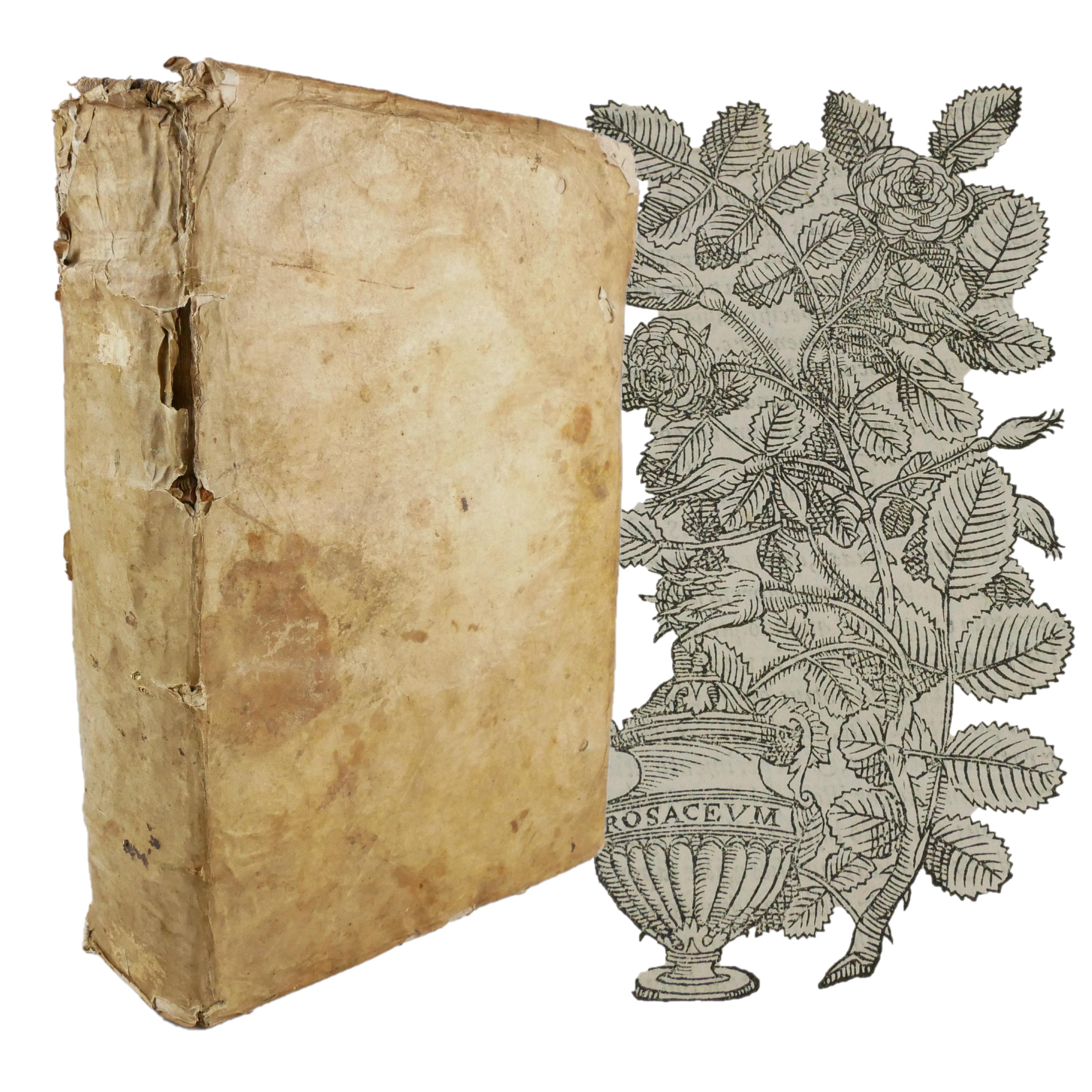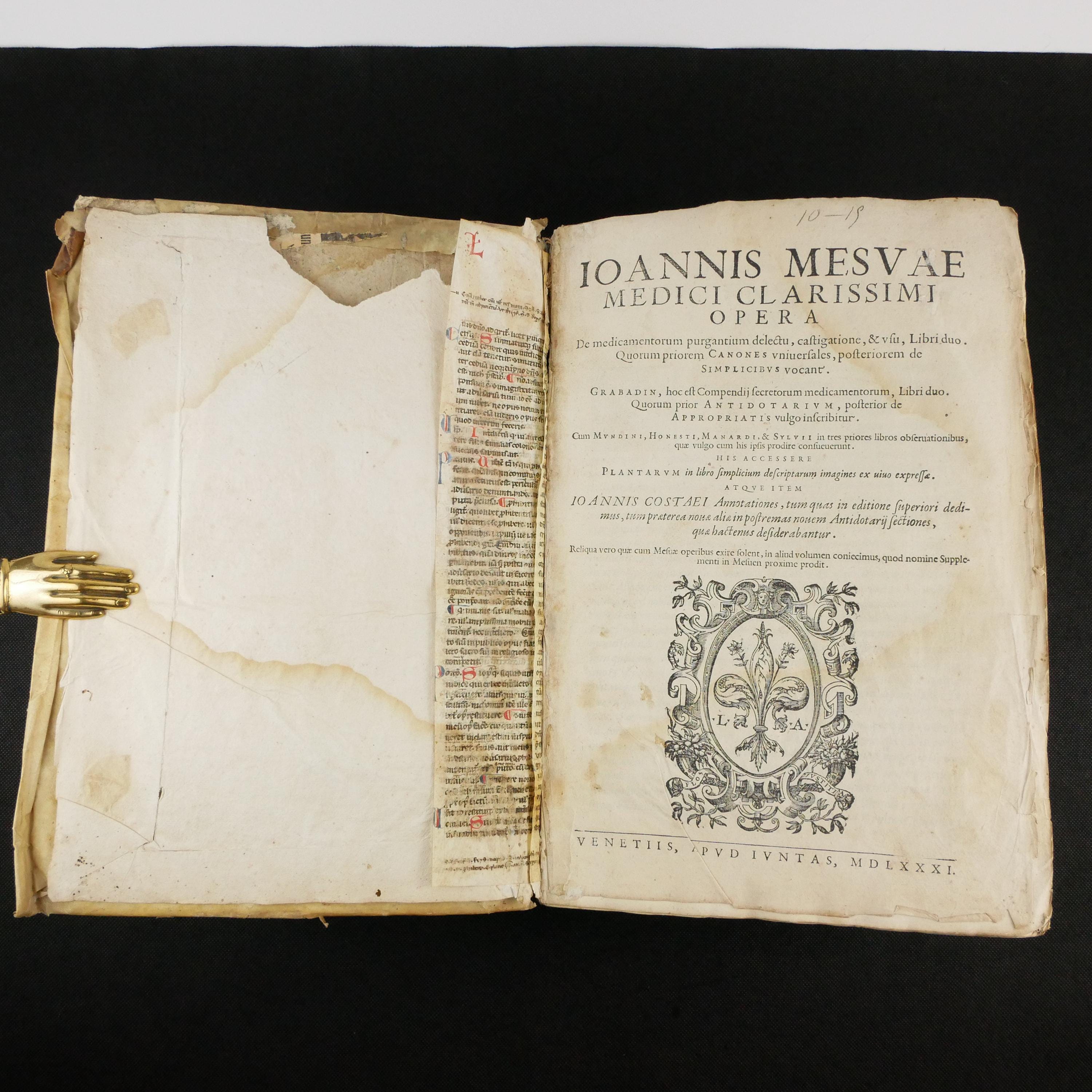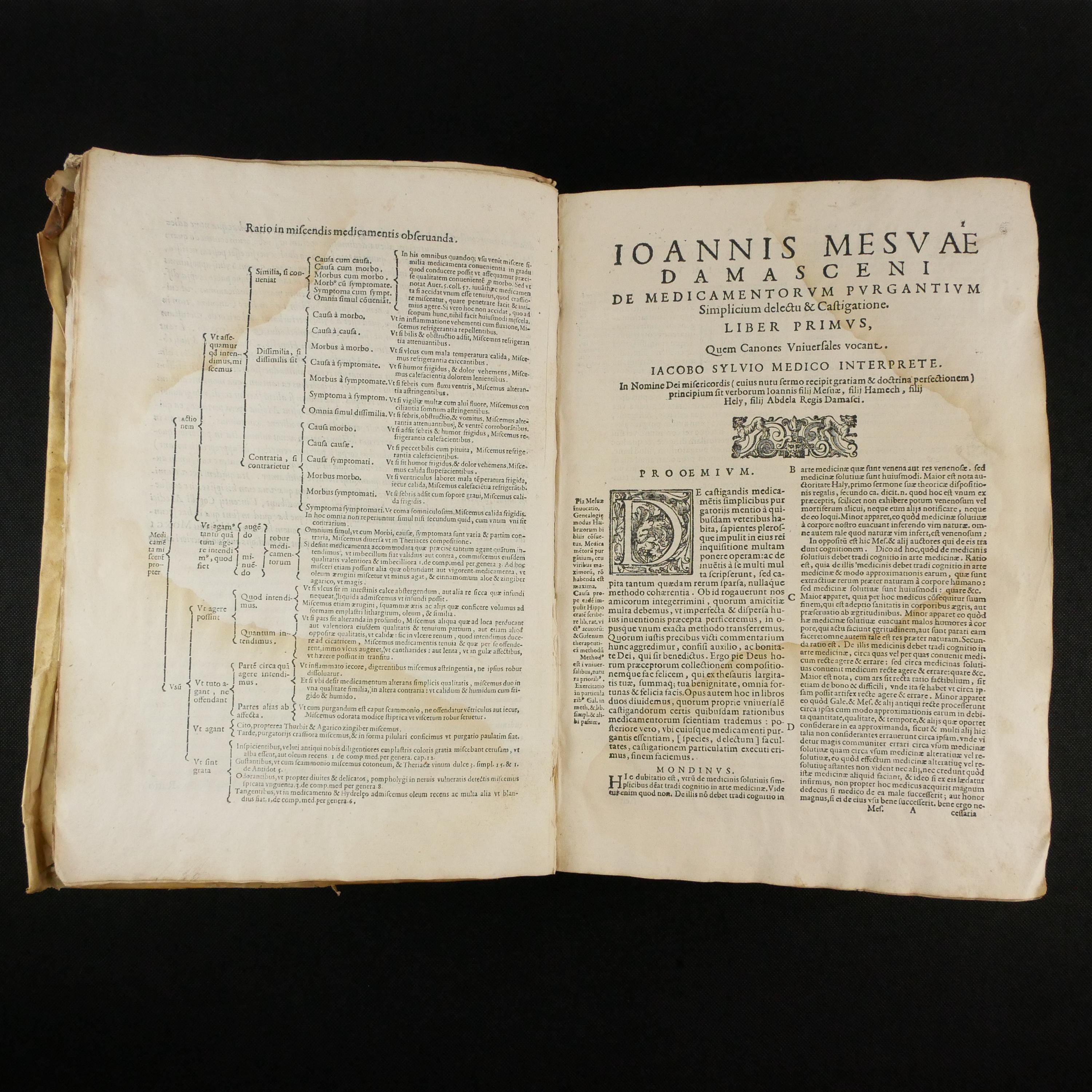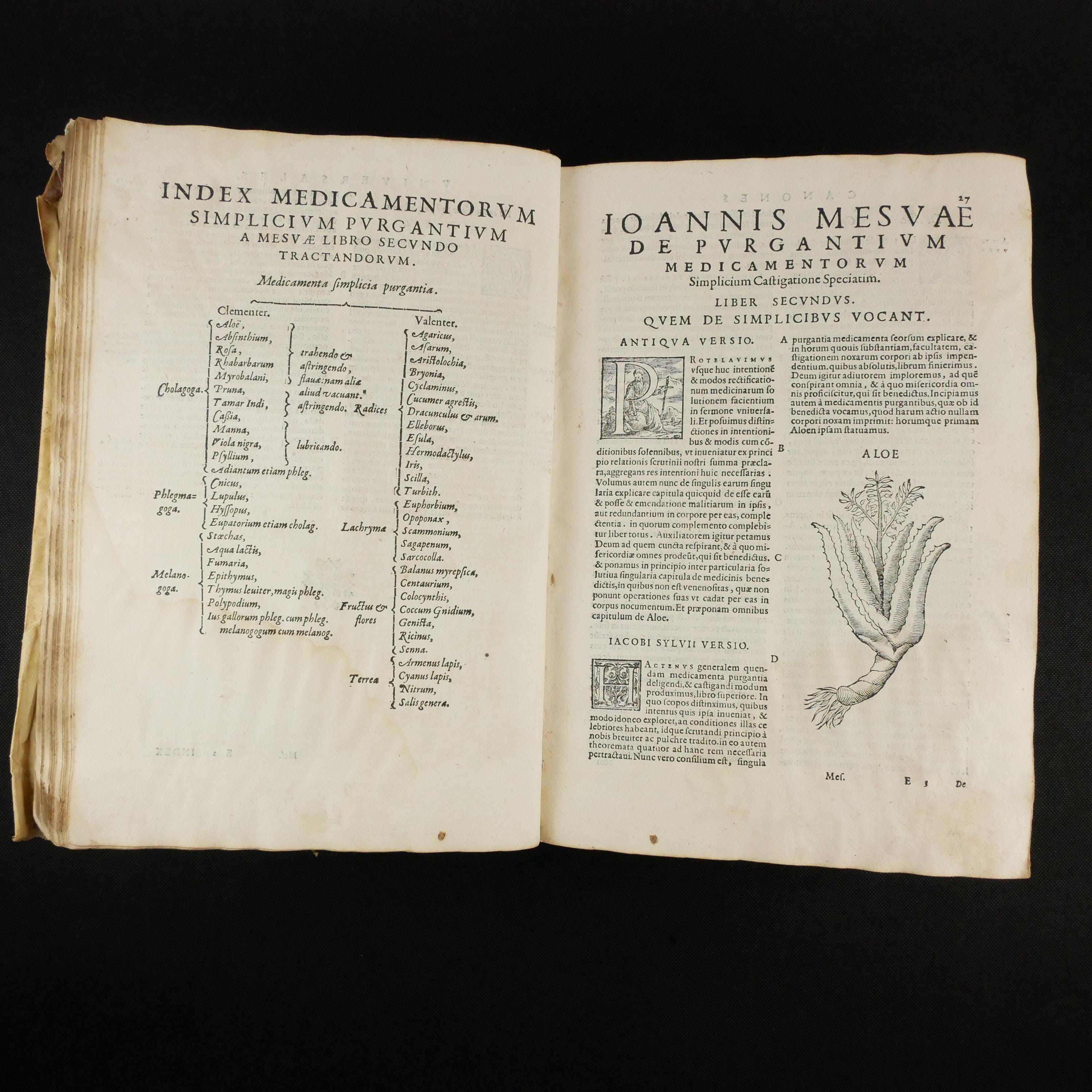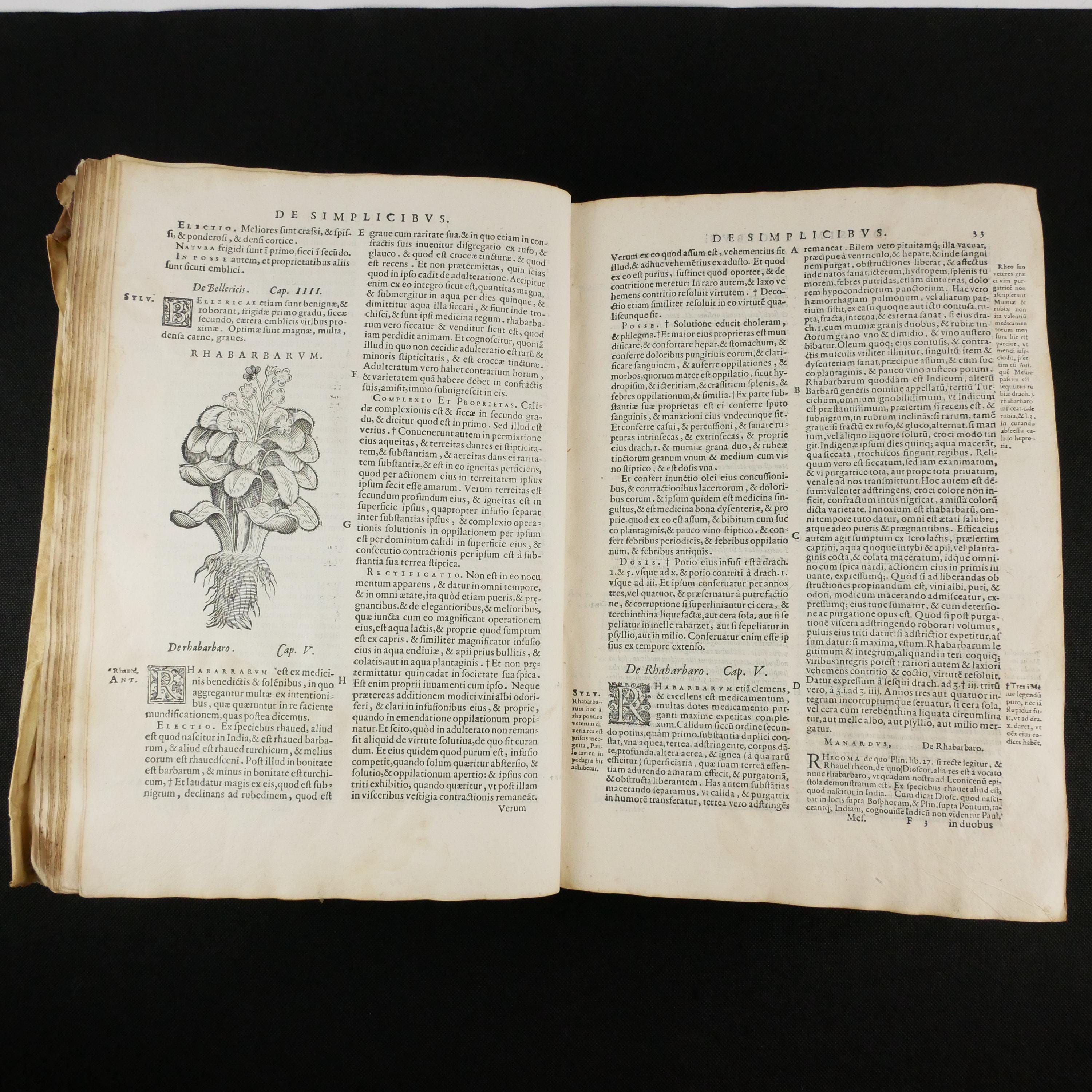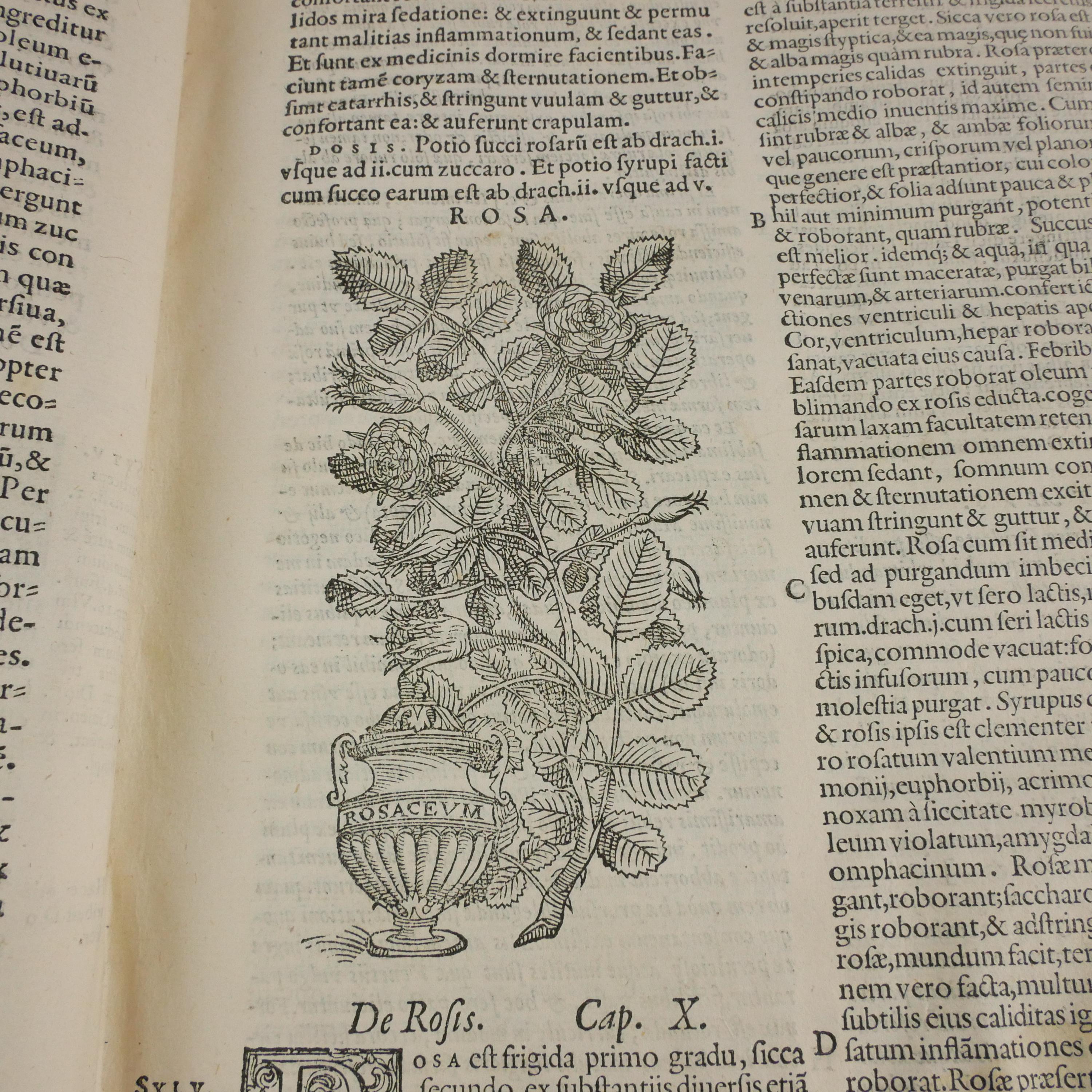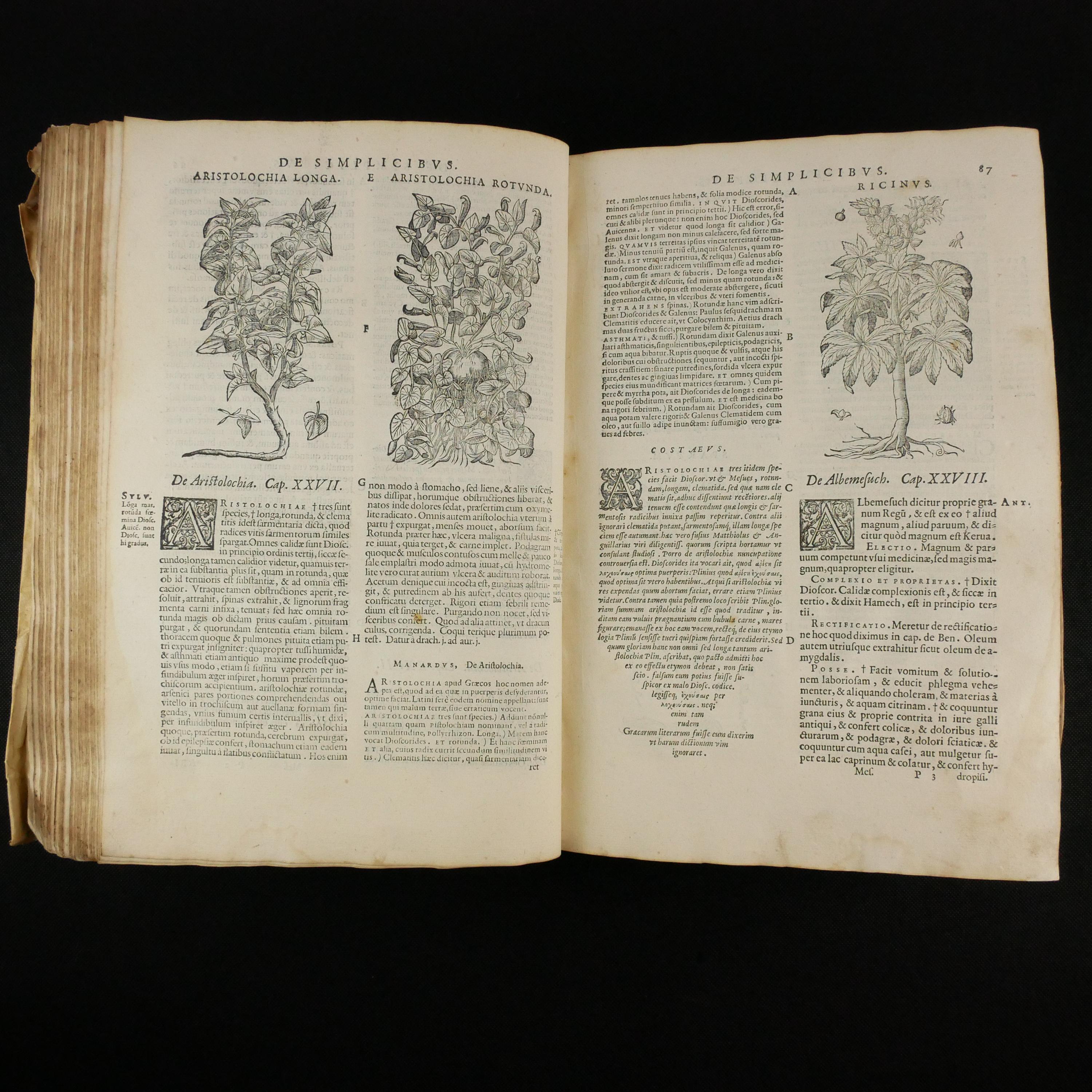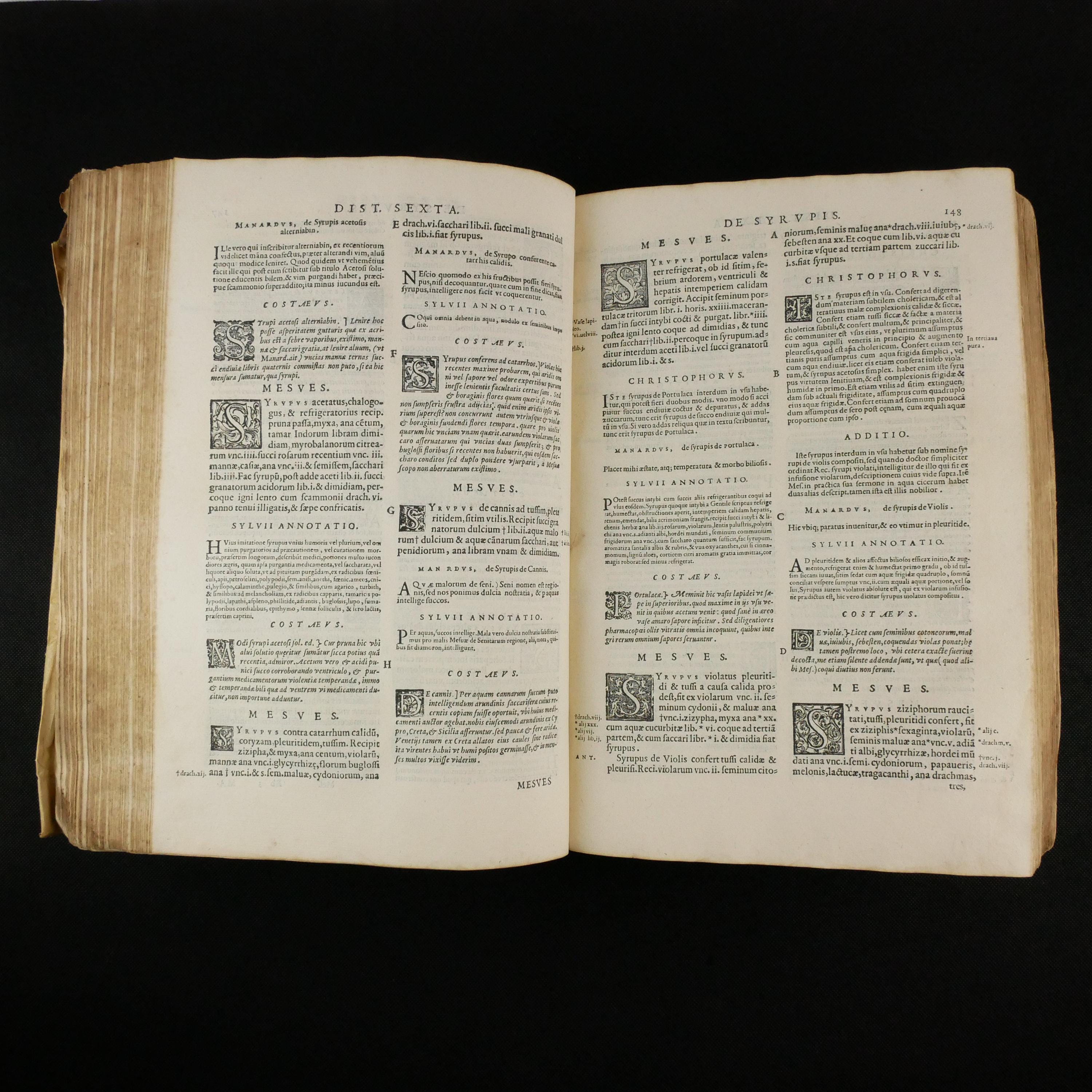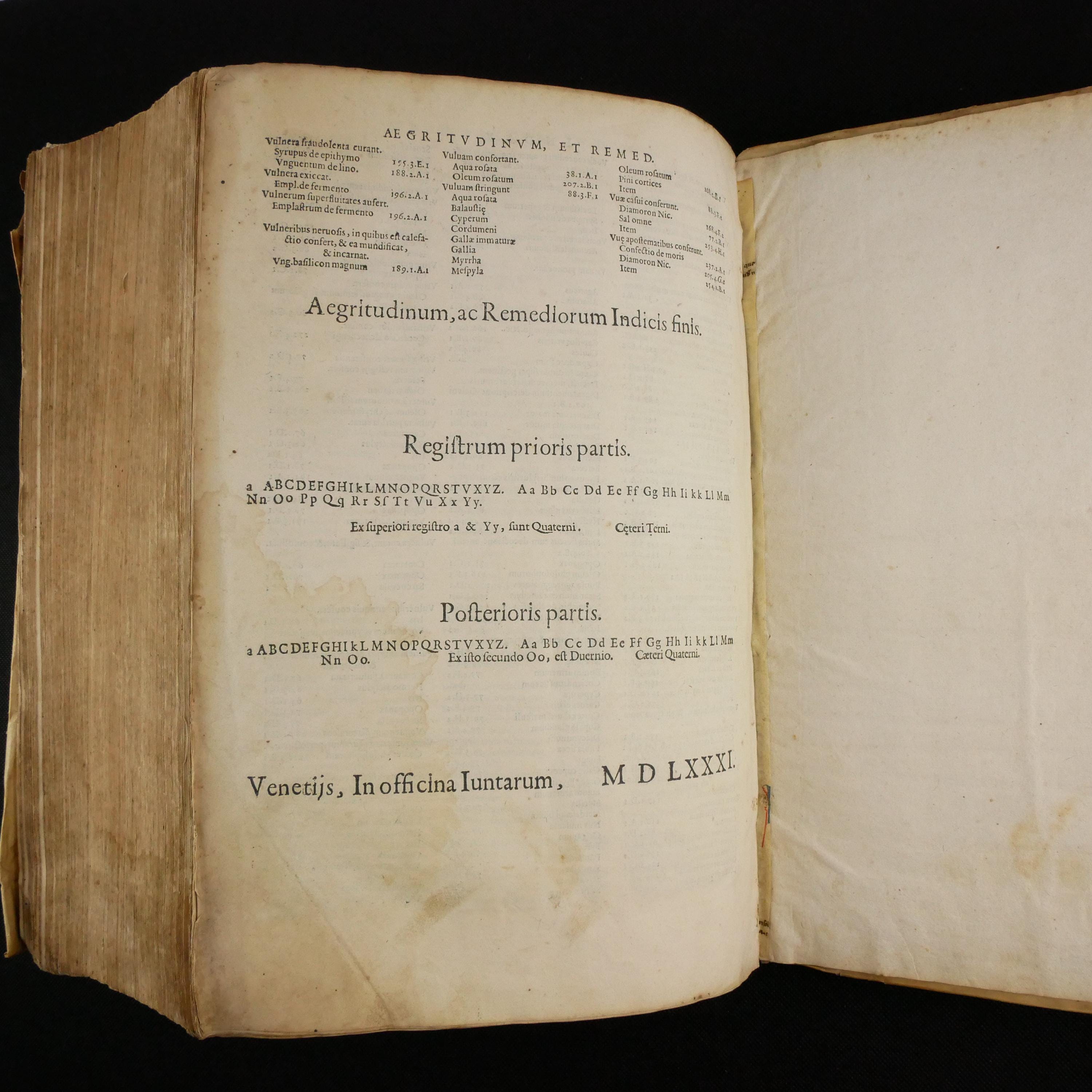1581 Joannis Mesuae Opera, de Medicamentorum Purgantium Delectu... Giunti,Venice
$3,499.99
1581 printing of the works of the 9th and 10th century Christian herbalists and physicians, Yuhanna ibn Masawaih (Mesua, Mesue the elder) and Masawaih al-Mardini (Mesua, Mesue the Younger); both authored many works and practiced medicine in Baghdad. It appears this printing may have mistakenly attributed works of Mesue the Elder and Younger to one person (see more below), and it's known that these works circulated under a name "Jean Mesue" with various additions and edits throughout the middle ages.
Because Mesua the Younger provides recipes for fruits prepared with granulated sugar, some consider Mesua to Younger to also be a father of modern confectionary; his syrups and jams are included in this printing.
This copy also with a large piece of manuscript "waste" used in the binding, which contains a portion of Justinian law from the Digests.
This edition printed by the venerable Giunti family, in Venice, with 39 large botanical engravings decorating al-Mardini's pharmacopia, Antidotarium; in addition to numerous decorated and inhabited printed initials (among other typographical devices).
About the Works
The first title page, in addition to the Mesue works listed, states that the first book includes the input of al-Mundini (Mesue the Younger), Honesti, Manardi, and Sylvii. Also, Joannis Costaei provides annotations.
The first part, De Medicamentorum Purgantium... Simplicibus, is now attributed to Masawaiyh the Elder. The first portion of this section of the work seems to be drawn from Mesue's aphorisms, the marginal printed annotations noting which "Aph." the text is drawn from. The second portion is the work Simplicibus, this is a work which can be roughly translated, On Simple Aromatic Substances; here is where the printer included the 39 botanical illustrations.
The second work, Grabadin... Andtidotarium, is now attributed to Mesue the Younger; this work is a link between medicine and confectionary. In the 10th century recipes were beginning to incorporate granulated sugar, rather than honey, and Mesue the Younger incorporates those recipes into this work; there are sections on fruit jams and syrups leading some (Liliane Plouvier, historian specializing in food and confection, for example) to say that Mesue the Younger is a father of modern confectionary.
Here's a breakdown of what can be found in some of those sections -
- De electariis delectabilis in Chapter I: sugar jams
- De conditis in chapter IV: recipes for flowers, spices and fruit, candied (quince, apple, pear, peach, lemon peel, ginger, violet, pink).
- De speciebus loch in chapter V: the loch is translated from The Arabic la'uq and refers to confectionery, a legacy of the Greeks and then the Arabs (nougats, marzipan, varieties of candies such as berlingot and Turkish delights).
- Syrupis and robub in Chapter VI: recipes for syrups from apples, pears, quinces, plums, mint, grenadine (medicinal products and thirst-quenching recipes) and robs recipes (from the Arabic rubb: juice).
Behind these books, we have a second work on remedies for different parts of the body; this is also attributed to Mesue. In this part, there is a section on the eye, which is now attributed to Mesue the Elder, and is considered a pioneering and important work on the treatment of the eye.
Then comes a new title page, Supplementum in Secundum Librum.
The title page of the second work attributes the majority of the work to a Petri Apponi Patavini... I find that Pietro d'Abano (c1250 to 1316) prepared a work Mesue Emendatus (Text of Mesue amended). Biographies note "Pietro founded the Paduan School of medical thought, introducing both classical and Arabic sources".
The second title page also states that the work incorporates Galen and Hippocrates.
After the d'Abano work, other works are printed as part of the Supplementum. We find:
- Antidotarium Nicolai cum expositionibus et glossis.... Joannis Platearii
- Expositio Joannis de Sancto Amando, Tornacen
- Gentilis Fulginatis de Proportionibus Medicinarum Solventium... This section seems to be attributed to Servitoris.
- Saladini de Asculo - Serenitatis principis Tarenti Physici Principalis Compendium Aromatariorium
- Albengnefit Libellus in quo de simplicium medicinarum...
- Jacob Alchindi Auctoris praestantissimi in suum de medicinarum compositarum gradibus investigandis libellum praefatio
- Insignis Medici Cophonis tractarus de are Medendi...
About the Manuscript Waste -
The support used between the binding and the text block, was taken from a manuscript written on velum (termed "manuscipt waste"), and it is a portion of Justinian law from the Digest. This passage is from book 43, a section generally titled Quod vi aut clam. This section is recognized as parts 43.24.18.1 to 43.24.22.1 in the online Latin Library posting of the Digest. The manuscript may (slightly) relate to the book, this section of the Digest is regarding the laws of agriculture, ownership, tenants, trees, etc.
Bibliographic Details -
Universal Short Title Catalogue number 842298; 34 copies listed in the world's libraries.
Worldcat OCLC number 44822224, among others.
Censimento Nazionale delle Edizioni Italiane del XVI Secolo - 27626
Physical Attributes -
Measures approx. 20 x 13 x 4 cm. Leather dark-red morocco binding. Boards with triple gilt fillet borders with corner florets. Central gilt medallion of the Duc de Berry on front and back. Spine with five raised bands; two rolls at bottom of spine alternating a flower with a circle with a tiny flower inside, five compartments with a central gilt bouquet emanating from a vase surrounded by swirling branches and a flame tool, one compartment with the title. Board edges and turn-ins rolled with a gilt alternating flower and triple frame square. All edges gilt, but with an underlying marble. Silk endpapers.
Pages – Pt.1 xvi, 272. Pt. 2 xii, 1-277 (278 blank), [9 leaves index, one blank]
Pt. 2 B4-B8 misnumbered.
Collation – Pt. 1 a8, A-Z6, Aa-Xx6, Yy8. Pt. 2, a6, A-Z8, Aa-Ll8, Mm6, Nn6, Oo4
39 engravings of plants found at leaves signed (R-recto, V-verso) E3R, F2V, G2R, G3V, G5R, G5V, G6V, H1V, H2V, H3V, H4V, H5V, H6V, I1V, I5V, K1V, K3R, K4V, K5V, L1R, L2R, L3V, L5R, L6Vone, L6Vtwo, M2R, M5R, O2Vone, O2Vtwo, O3Vone, O3Vtwo, O6R, P1V, P2Vone, P2Vtwo, P3R, P3V, P5Rone, P5Rtwo
Condition -
See pictures. Vellum binding worn, cockled, worn through at edges and joints, some cracking at joints. Tie straps expired leaving stubs. Front pastedown lifted exposing pasteboard and crash (of old manuscript). Ink shelf mark at top margin of a1. a1 mounted (title page), moisture mark throughout (to page 37 from fore-edge and into text, after 37 it’s from the bottom corner; after the V gathering the moisture mark is mostly within the bottom margin). Toned throughout with some waviness to pages. Marginal 1” tear at B3. Some thumbing, occasionally a smudge of ink. Some dog-eared pages. S2 bottom edge tear, no text affected. Hh1 corner chipped. There are remainders on a handful of corners (original leaf corner folded down so not trimmed by binder) Pp6, Rr5, P2 C1. In Pt 2 some rust spots in I and K gatherings. Pt2 T-Z gatherings with a worm track from the bottom edge that just touches the catch words.
Shipping from United States
Processing time
1-3 business days
Customs and import taxes
Buyers are responsible for any customs and import taxes that may apply. I'm not responsible for delays due to customs.
Payment Options
Returns & Exchanges
I gladly accept returns
Just contact me within: 7 days of delivery
Ship items back to me within: 14 days of delivery
I don't accept exchanges or cancellations
But please contact me if you have any problems with your order.
Conditions of return
Buyers are responsible for return shipping costs. If the item is not returned in its original condition, the buyer is responsible for any loss in value.
Privacy policy
We do not collect any private information. For billing, Etsy provides the service. We only receive notice that payment was made. The shipping address is provided to us by Etsy, based on what they buyer submitted during check-out. We do not store these addresses. That is the extent of the information that we receive during a transaction.
